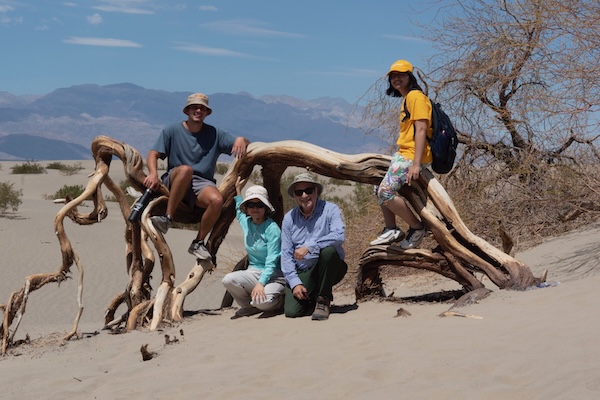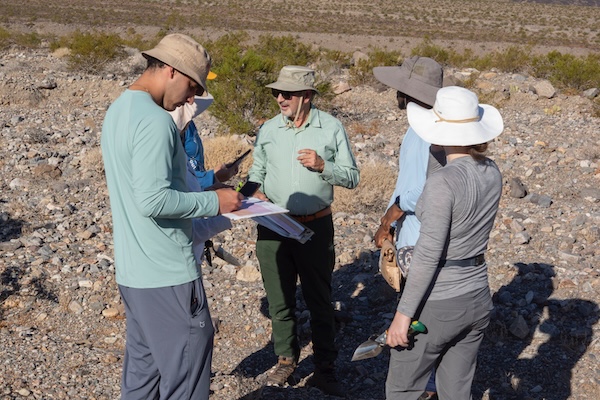
In his 40 years at the University, Professor of Biology Frederick Cohan has contributed to an august history of natural sciences, taught classes in evolutionary biology, ecology, and bioinformatics, and conducted dynamic research on bacteria. Now a Huffington Foundation Professor in the College of Environment (COE), Cohan sat down with The Argus to talk about his recent research in Death Valley, the interdisciplinary sciences, and how he has seen the University change over the years.
The Argus: What first sparked your interest in evolutionary biology?
Frederick Cohan: I can’t even tell you really. I just found it the most interesting subject in college. I went to college at Stanford, and I did an honors project as an undergraduate some 50+ years ago about the hybridisation of oak species. I just thought the idea that species could learn new adaptations from other species through hybridization was fascinating. When I moved to bacteria, that possibility of inter-species gene exchange became so much more rampant and intriguing.
A: Sometime in your career you specialized in evolutionary bacteriology, what did that change look like for you?
FC: Why would anyone work with flies? I used to study Drosophila (a genus of flies) before bacteria. Bacteria are so interesting. Flies are very difficult in terms of the husbandry—you can’t just stick them in the freezer and come back when you’re interested. With bacteria you can do that, and I think that makes them so much nicer to work with. Finish a project, stick them in the freezer, and say, “Yeah, I’m going on vacation.”
I got a post-doctorate job at the University of Arizona, which was my opportunity to study bacteria. I learned bacteria from John Spizizen—I’ll call him the grandfather of Bacillus Genetics. With the help of Conrad Istock at the University of Arizona, I became interested in the evolutionary ecology of Bacillus. I learned that I could collect it myself in the desert, and so we collected thousands of strains and have been studying them ever since. One of my ambitions was to discover how one bacterial species can split into two lineages—two lineages that can co-exist indefinitely because they’re ecologically different enough to do so.
A: Tell me about your research this summer.
FC: We went to Death Valley this August, for six days overall. The reason to go to Las Vegas—as everyone should know—is that it’s the gateway to Death Valley. The last time I did a major Bacillus collection there with my students was seven years ago, and then we collected Bacillus from different environments and elevations: below sea level, at sea level, up to 10,000 feet.
This year, we were also looking at free soil and rhizosphere soil. An ecotype is basically a lineage that is ecologically homogenous and can co-exist forever with other ecotypes which it is ecologically different from. We’ve now shown that there’s at least several to many ecotypes in what people call a species—we used to think there might be a gazillion. In the work we’ve done so far, we found that there are a small number of ecotypes in each of the three focal species we’ve worked on, and they’re all interestingly different.
So we took a new approach to sampling the diversity based on single genes. We wanted to compare the “modal genes” (given the modal number of ecotypes, five), with the high ecotype numbered genes with a PCR process. Our research methodology has evolved, because we’re doing a much more detailed environmental characterisation with chemical analysis of soil beyond just elevation and soil type consideration.
It’s only been in the last year or so that we’ve actually figured out how to identify ecotypes, and how to determine that there’s really only a countable number of ecotypes for a species. To some extent you can take pride in knowing there’s lots of species, and sometimes you can say it’s an annoyance to know there’s so many. If there’s a billion of those [ecotypes] then you lose interest because it becomes fruitless to identify, name, and study interesting ones.
This is work that really is based on the work of a dozen undergraduate students, B.A/M.A students. What we’ve done is sampled the sequence diversity of a gene, and found out how many sequence clusters there are, looking at the similarities and differences. We invented an algorithm that goes from the sequence clustering and identifies clusters that are ecotypes—and we’ve never got more than 10 ecotypes. And now we’re working on making a coffee table book on Bacillus! Some colleagues of mine are making coffee table books on fish, and Bacillus are so much more interesting than fish of course. The book’s going to be like a stamp collection of Bacillus.
A: Could you say more about how you imagine the book in parallel with stamp collection?
FC: I was a stamp collector as a kid. We are interested in making a complete registry of all bacterial species. Some people have estimated that there’s a trillion species. We have a long way to go to get to all of these obviously; we’ve only named about 20,000 so far. The way people have thought about reaching the entirety of bacterial diversity is by automating it. Based on the genome instead of necessarily culture, I imagine that we are going to have this big stamp collecting book of species. If you’ve ever seen a stamp collecting book, you’ll note that there are pages that are printed, meant to be filled in when you get the stamp. I think of this as being the book of life, where you can have something in principle based on genome sequence before even having them in culture.
A: What is your favorite class you have taught at Wesleyan?
FC: That would be “Global Change and Infectious Disease” (BIOL173). Before teaching that class I wasn’t really familiar with the topic, but I read this book “Six Modern Plagues and How We Are Causing Them” by Mark Jerome Walters. What I found really interesting about this book, not having studied infectious diseases before this, was that he made a case to a popular audience that there’s all these ways we alter the environment that brings us novel infectious diseases. The way I teach the course—going chronologically through history—the ways we have disturbed the environment are related to procuring food, disturbing human population density, usage of land, the global transportation of organisms, harnessing energy, and the last is healthcare.
The punchline of all this in the course is that there’s always going to be an unending parade of plagues, and we cover how to fix them. What happened before this class got popular with students is that students would take the course and decide that they wanted to go into public health. So many students have gone into that not expecting that [it] would be their career. I figure we need a lot more people in public health—more than we do in studies of origins of bacterial species. So I’m happy to teach that class to as many people who want to take it.

A: You’ve been here nearly 39 years. How have you seen the University change?
FC: I finished my 38th year working here this May. This place is amazing. Something I started to appreciate after my first decade here is the great interest in interdisciplinarity here. And it started across the street. You folks, your professors from a decade ago were very interested in doing research across divisions, teaching classes across divisions, and that, as a spectator, was pretty interesting. In retrospect, I think I came here as a scientist pretty blindered.
In the last 20 years, the sciences here have become much more interdisciplinary. So here’s an example: one of my closest colleagues, [Professor of Computer Science] Daniel Krizanc, is a computer scientist. We’ve co-authored papers a dozen times, taught a class together five times, he comes to all my lab meetings. And he wasn’t a biologist when we started, but he is now. And I wouldn’t say that I’ve become a computer scientist, but I will say that I wrote the cotype simulation code with his help. And I just think that interdisciplinary learning spirit, even within faculty, is so great.
The College of the Environment (COE) is also a great example of how the sciences have evolved here. I was one of the founding professors for the COE and will be chair of the Environmental Studies major program next year. The COE is an amazing interdisciplinary program that encourages students to apply what they are learning in their principal major toward solving environmental challenges. At this point, nearly every major or program has been represented among our COE graduates.
A: What does your off time look like?
FC: On vacation, I usually work in the mornings and then my wife and I hike all afternoon, go out for dinners. This recent vacation I wrote the algorithmic code for the ecotype simulation.
A: How do you think the University has accommodated and facilitated the growth of the Natural Sciences Department over the years?
FC: We have been supported by the University to have the teaching load that allows us to seriously engage with our students and our work. The deal is we teach the number of courses that allows us to connect with students in our classroom—which is amazing. But we also have time to be working in the lab every week, working with our students elbow-to-elbow every week. [There are] so many students who are interested in working with us. The past few years I’ve had 16 to 18 students in my lab every year—which is a lot—but we have found a way to make that work. I’ll say the B.A./M.A. program has been a change that has allowed the University to support students who have been here for a few years as undergraduates, and this gives them an additional year to advance their scientific careers. I’ve had a B.A./M.A. student every other year in the past years, and it’s worked out beautifully. The University supports us in contributing to knowledge, and also in our training of students.
A: Are there any non-biology/ecology books you’ve been reading lately?
FC: A book that I found out about recently is a new one by Timothy Snyder, one of my favorite authors. His last book was on tyranny, and we get tired of that. But his new book is “On Freedom.” His idea is that we typically think of freedom as freedom from oppression, government, control et cetera, but he wants us to think of it as freedom to love who you want, to talk about what you want, and I think that’s just so interesting. I also love Eugenia Cheng, who is a mathematician who writes math books for laymen, which are all great. I’ve read three of her books so far. I just read “Is Math Real?” by her. She opens a lot of avenues to talk about math in her books, which is pretty amazing.
Correction: An earlier version of this article mentioned Professor Cohan as the founding professor of the College of the Environment. This has been corrected to reflect that he was one of multiple founding professors.
Janhavi Munde can be reached at jmunde@wesleyan.edu.

